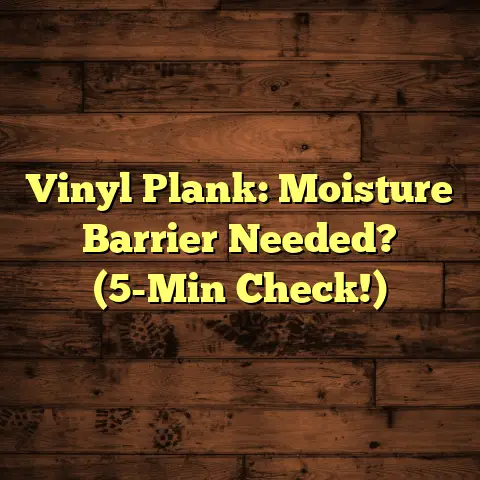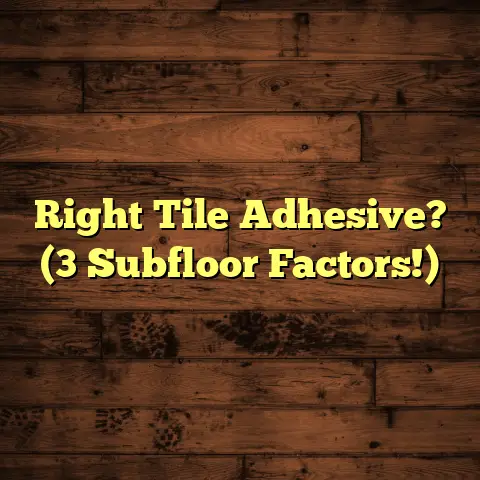Tile Glue Removal: The Pro Secrets! (3 Hacks)
I’ve seen it all, from glorious hardwood installations to, well, the aftermath of some interesting DIY tile jobs.
And let me tell you, one of the biggest headaches I see homeowners face is removing that stubborn tile glue.
But it’s not just about aesthetics, folks. It’s about your health.
That residual tile adhesive can trap dust, allergens, and even harmful bacteria, creating an unhealthy living environment.
Think about it: your home should be your sanctuary, a place where you can breathe easy.
But if you’ve got lingering tile glue lurking beneath your new floors, it could be contributing to poor indoor air quality.
This is especially crucial for families with children, elderly members, or anyone with respiratory issues.
We’re talking potential allergy flare-ups, asthma triggers, and just generally feeling “off.”
The good news? You can tackle this!
Removing tile glue effectively isn’t just a home improvement task; it’s a crucial step towards ensuring a healthier home.
I’m going to share three professional hacks that I’ve learned over the years for effective tile glue removal.
Let’s get started!
Section 1: Understanding Tile Glue and Its Impact
So, what exactly is this stuff we’re battling? Let’s break it down.
Overview of Tile Adhesives
Tile glue, or tile adhesive, is the umbrella term for a bunch of different materials used to bond tiles to a subfloor.
The most common types you’ll encounter are:
-
Thin-set Mortar: This is a cement-based adhesive, usually mixed with water or a latex additive. It’s incredibly strong and durable, making it ideal for wet areas like bathrooms and showers. It is also the most difficult to remove.
-
Mastic: This is a pre-mixed, organic adhesive that’s easier to work with than thin-set. However, it’s not as water-resistant, so it’s generally used in drier areas like kitchens and backsplashes.
-
Epoxy Mortar: This is a two-part system that creates an incredibly strong and chemical-resistant bond. It’s often used in commercial settings or for specialty tile installations.
Each type has its pros and cons, but they all share one thing in common: when they dry, they create a tough, tenacious bond that can be a real pain to remove.
Health Risks Associated with Residual Glue
Now, let’s talk about the not-so-fun part: the potential health risks associated with leftover adhesive.
As I mentioned earlier, residual glue can harbor harmful microorganisms. Think mold, mildew, and bacteria.
These microscopic critters thrive in damp, dark environments, and leftover adhesive provides the perfect breeding ground.
According to the EPA, poor indoor air quality can lead to a range of health problems, including: EPA Indoor Air Quality
- Irritation of the eyes, nose, and throat
- Headaches
- Dizziness
- Fatigue
- Respiratory problems
- Allergies
- Asthma
And that’s not all. Some older adhesives may contain volatile organic compounds (VOCs), which are chemicals that can evaporate into the air and cause health problems.
VOCs can contribute to “sick building syndrome,” a condition characterized by a variety of symptoms like headaches, fatigue, and difficulty concentrating.
Signs of Poor Indoor Air Quality
How do you know if you’re dealing with poor indoor air quality due to tile glue remnants? Here are some telltale signs:
-
Persistent Allergies: Are you constantly sneezing, coughing, or experiencing itchy eyes, even when it’s not allergy season?
-
Asthma Flare-Ups: Are you or a family member with asthma experiencing more frequent or severe attacks?
-
Musty Odors: Do you notice a persistent musty or moldy smell, especially in areas where tile was previously installed?
-
Visible Mold Growth: Can you see mold growing on or around the subfloor?
-
General Discomfort: Do you just feel generally unwell when you’re inside your home?
If you’re experiencing any of these symptoms, it’s worth investigating the possibility of poor indoor air quality.
Removing that old tile glue could be the key to breathing easier and feeling better.
Section 2: Hack #1 – The Power of Heat
Alright, let’s get into our first pro hack: using heat to soften tile glue.
Why Heat Works
The science behind this is pretty simple. Heat makes the adhesive more pliable and less brittle.
Think of it like warming up a piece of chewing gum. When it’s cold, it’s hard and difficult to stretch.
But when you warm it up, it becomes soft and stretchy. The same principle applies to tile glue.
By applying heat, you’re essentially weakening the bond between the adhesive and the subfloor, making it easier to scrape off.
Tools Needed
For this method, you’ll need the following tools:
-
Heat Gun or Hairdryer: A heat gun is ideal because it produces a more concentrated and consistent heat. However, a hairdryer can work in a pinch, especially for smaller areas.
- Safety Note: If using a heat gun, be extremely careful not to overheat the area, as this can damage the subfloor or even start a fire.
-
Scrapers: You’ll need a variety of scrapers, including a wide scraper for large areas and a narrow scraper for tight corners.
-
Putty Knife: A putty knife can be helpful for getting under the edges of the adhesive.
-
Safety Glasses: Protect your eyes from flying debris.
-
Gloves: Protect your hands from heat and sharp edges.
-
Respirator (Optional): If you’re concerned about dust or fumes, a respirator can provide extra protection.
Step-by-Step Guide
Here’s how to effectively use heat to remove tile glue:
-
Prepare the Area: Clear the area of any furniture or debris. Protect any nearby surfaces with drop cloths or plastic sheeting.
-
Apply Heat: Hold the heat gun or hairdryer a few inches away from the adhesive and move it slowly back and forth. Focus on one small area at a time (about 6-12 inches square).
-
Soften the Glue: Continue applying heat until the adhesive becomes soft and pliable. This may take a few minutes, depending on the type of glue and the strength of your heat source.
-
Scrape Away: Use a scraper or putty knife to scrape away the softened adhesive. Apply steady, even pressure and work in a consistent direction.
-
Repeat as Needed: Repeat steps 2-4 until all of the adhesive has been removed.
-
Clean the Subfloor: Once you’ve removed all of the adhesive, clean the subfloor with a damp cloth to remove any remaining residue.
Pro Tips
-
Gauge the Right Temperature: Start with a low heat setting and gradually increase the temperature until the adhesive softens. Avoid overheating the area, as this can damage the subfloor.
-
Test in an Inconspicuous Area: Before you start working on the entire area, test the heat method in an inconspicuous spot to make sure it doesn’t damage the subfloor.
-
Work in Small Sections: Focus on one small area at a time to prevent the adhesive from cooling down and hardening before you can scrape it away.
-
Use the Right Scraper: Choose a scraper that’s appropriate for the type of adhesive you’re dealing with. A wider scraper is best for large areas, while a narrow scraper is better for tight corners.
-
Be Patient: Removing tile glue can be a time-consuming process, so be patient and don’t rush.
Section 3: Hack #2 – Solvent Solutions
Our second pro hack involves using solvents to dissolve the tile glue.
Understanding Adhesive Solvents
Adhesive solvents are chemicals that break down the bonds in the adhesive, making it easier to remove.
Some common solvents used for tile glue removal include:
-
Acetone: This is a strong solvent that can dissolve many types of adhesives. However, it’s also highly flammable and can be harmful if inhaled, so it’s important to use it with caution.
-
Vinegar: This is a natural solvent that’s less toxic than acetone. It’s not as effective on tough adhesives, but it can work well on milder glues.
-
Commercial Adhesive Removers: These are specially formulated solvents designed to remove tile glue. They’re often more effective than acetone or vinegar, and they may be less toxic. Some popular brands include Goo Gone Pro-Power Remover and Motsenbocker’s Lift Off.
Safety First
Before you start using solvents, it’s crucial to take some safety precautions:
-
Wear Protective Gear: Always wear gloves, safety glasses, and a respirator when working with solvents.
-
Ensure Proper Ventilation: Work in a well-ventilated area to avoid inhaling harmful fumes. Open windows and doors, or use a fan to circulate the air.
-
Read the Label: Always read and follow the manufacturer’s instructions for the solvent you’re using.
-
Avoid Contact with Skin: Solvents can irritate the skin, so avoid contact. If you do get solvent on your skin, wash it off immediately with soap and water.
Step-by-Step Instructions
Here’s how to apply solvents to tile glue:
-
Prepare the Area: Clear the area of any furniture or debris. Protect any nearby surfaces with drop cloths or plastic sheeting.
-
Apply Solvent: Apply the solvent to the adhesive, following the manufacturer’s instructions. You can use a brush, a sponge, or a spray bottle.
-
Let it Sit: Allow the solvent to sit on the adhesive for the recommended amount of time. This will give the solvent time to break down the bonds in the glue.
-
Scrape Away: Use a scraper or putty knife to scrape away the softened adhesive. Apply steady, even pressure and work in a consistent direction.
-
Repeat as Needed: Repeat steps 2-4 until all of the adhesive has been removed.
-
Clean the Subfloor: Once you’ve removed all of the adhesive, clean the subfloor with a damp cloth to remove any remaining residue.
Pro Insights
-
Choose the Right Solvent: Different solvents work better on different types of adhesives. Acetone is a good choice for tough adhesives, while vinegar is better for milder glues. Commercial adhesive removers are often the most effective option.
-
Test on a Small Area: Before you start working on the entire area, test the solvent in a small, inconspicuous spot to make sure it doesn’t damage the subfloor.
-
Allow Sufficient Soak Time: The amount of time you need to let the solvent sit on the adhesive will vary depending on the type of solvent and the type of glue. Follow the manufacturer’s instructions for best results.
-
Use a Scraper with a Sharp Edge: A scraper with a sharp edge will make it easier to remove the softened adhesive.
-
Ventilate the Area: Solvents can release harmful fumes, so it’s important to ventilate the area well.
Section 4: Hack #3 – The DIY Scraping Method
Our final pro hack is the good old-fashioned scraping method.
Why Scraping Works
Sometimes, the simplest solutions are the most effective. Scraping works by physically removing the adhesive from the subfloor.
This method is most effective when the adhesive is brittle and easily broken, or when you’re dealing with small areas.
Necessary Tools
For the scraping method, you’ll need the following tools:
-
Scrapers: You’ll need a variety of scrapers, including a floor scraper with a long handle for large areas, and a hand scraper for tight corners.
-
Putty Knife: A putty knife can be helpful for getting under the edges of the adhesive.
-
Hammer: A hammer can be used to tap the scraper for added force.
-
Safety Glasses: Protect your eyes from flying debris.
-
Gloves: Protect your hands from sharp edges.
-
Knee Pads: Protect your knees if you’re working on a large area.
-
Floor Buffer with Scraping Attachment (Optional): For larger areas, a floor buffer with a scraping attachment can save you a lot of time and effort.
Detailed Instructions
Here’s how to perform the scraping method properly:
-
Prepare the Area: Clear the area of any furniture or debris. Protect any nearby surfaces with drop cloths or plastic sheeting.
-
Position the Scraper: Place the scraper at an angle to the adhesive, with the blade facing down.
-
Apply Pressure: Apply steady, even pressure to the scraper and push it forward, scraping away the adhesive.
-
Use a Hammer (Optional): If the adhesive is particularly stubborn, you can use a hammer to tap the scraper for added force.
-
Repeat as Needed: Repeat steps 2-4 until all of the adhesive has been removed.
-
Clean the Subfloor: Once you’ve removed all of the adhesive, clean the subfloor with a damp cloth to remove any remaining residue.
Pro Strategies
-
Use a Sharp Scraper: A sharp scraper will make it easier to remove the adhesive. Sharpen your scraper regularly with a file or whetstone.
-
Work at an Angle: Working at an angle will help you get under the adhesive and lift it away from the subfloor.
-
Apply Steady Pressure: Applying steady pressure will help you remove the adhesive in a consistent manner.
-
Use a Floor Buffer with Scraping Attachment: For larger areas, a floor buffer with a scraping attachment can save you a lot of time and effort. These attachments use a rotating blade to scrape away the adhesive.
-
Be Careful Not to Damage the Subfloor: When scraping, be careful not to gouge or damage the subfloor. Apply even pressure and avoid using too much force.
Conclusion
So, there you have it: three pro hacks for tackling tile glue removal.
Remember, removing that old tile glue isn’t just about aesthetics. It’s about creating a healthier, safer living space for you and your family.
By eliminating the potential for mold, mildew, and other harmful microorganisms to thrive, you can improve your indoor air quality and reduce the risk of allergies, asthma, and other respiratory problems.
I know it can seem daunting, but trust me, with the right tools and techniques, you can tackle tile glue removal like a pro.
And the satisfaction that comes from achieving a clean and safe living space is well worth the effort.
So, grab your tools, put on your safety gear, and get to work!
I’m confident that you can do it.
Call to Action
Ready to take your home improvement skills to the next level?
Subscribe to my newsletter for more expert tips, tricks, and insights on flooring and home renovation.
Share your results with me! I’d love to see your before-and-after photos and hear about your experiences.
And if you have any questions about your tile glue removal project, don’t hesitate to ask.
Let’s build a community focused on enhancing home health and safety, one project at a time!





